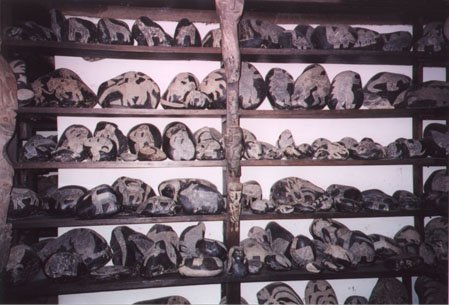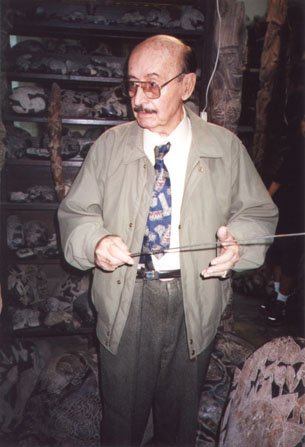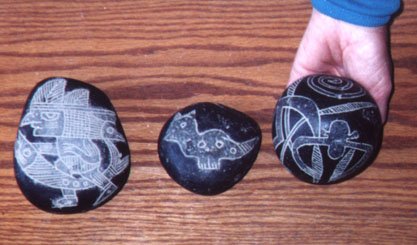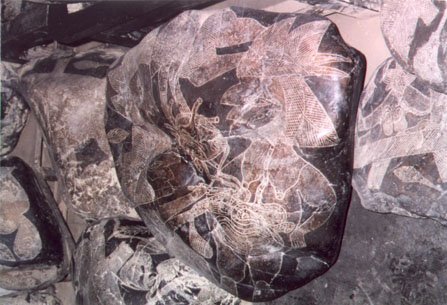Our visit with Dr. Cabrera
(This page is an exerpt taken from the travel journal website of
my trip to ancient
sites of South America in 2001. For the complete story of that trip, click above, or
visit my homepage to see
all of my ancient ruins travel sites.)
Once back on the ground (after having overflown the Nazca lines) we briefly
visited the very small museum there at the airport in Ica, and then our guide put in a
call to Dr. Cabrera, who was supposed to be the next item on the itinerary. We had made a
special point of making sure that we would be able to visit Dr. Cabrera on this trip,
since we were both very interested in seeing his collection of ancient stones. He has
amassed over 11,000 stones which were carved in some by-gone era, which show scenes from
an ancient civilization that has since disappeared without a trace (except for the
stones). The artwork on the stones show scenes of man interacting with dinosaurs,
performing heart transplants and other highly advanced medical procedures, and other such
concepts that if true would force a re-write of the timeline of history. Unfortunately,
because this concept is so radical, and because it was initially reported that the stones
were a hoax, it has been impossible to get the scientific community to study the stones
(or even to take them seriously). We wanted to see the stones for ourselves, and to talk
with Dr. Cabrera in person (although this has to be done through a bilingual translator,
as Dr. Cabrera speaks Spanish).
The housekeeper for Dr. Cabrera informed our guide that he wasn't feeling well
today, and that he was not seeing any visitors. Since the stones are stored in an annex of
his house and are under his protection, it is impossible to see the collection without him
being present. Luckily our guide was able to do some fast talking and convinced the
housekeeper to let us meet with the doctor for a little while.
We met Dr. Cabrera at his house on the main plaza of Ica, and were invited
inside, where I used some memorized lines of Spanish to say that it was an honor to meet
him and to thank him for receiving us that day. We each presented him a small gift (I gave
him a laser pointer, to help with his presentations, and Sue gave him a "space
pen", which was designed by NASA to write under any conditions), and then he took us
to the adjacent rooms where the majority of his stone collection is kept.

One section of one of the storehouse walls, containing shelves
full of Ica Stones. The stones are grouped by category, and this group seems to show
animals that are supposed to have been extinct when man walked the planet. Note the stone
second from the left on the second shelf, which seems to show a man riding a creature that
looks like a cross between a horse and a brontosaurus.

Doctor Javier Cabrera gives a tour of one of the areas in his
museum that is filled floor to ceiling with the Ica Stones. He is holding a steel rod that
he used as a pointing stick during his demonstration.
Dr. Cabrera would point out the most interesting stones, and explain the
significance of the designs on them. Our guide translated his statements, while I filmed
as much as I could on the camcorder and Sue took a number of 35mm photos. We were allowed
to feel the weight of some of the palm-sized stones, which seemed to weigh more than a
standard stone of that size should. We were told that these stones had a higher
"gravity" (density? weight?) than normal stones, and it seemed to be true.

Here are three of the Ica Stones that we were allowed to handle
and examine closely. The first shows a man with the classic feathered headress of the men
depicted on all of the Ica Stones. He is standing astride a long fish, with the head of a
bird either on the end of his headress, or on a neck that is part of the fish's fin. The
next stone shows a strange creature standing on two legs, with a bird's head and beak, the
ears of a cat, circular spots on his body, and a striped tail like that of a lizard. The
third stone had a design that wrapped around it. While the first two stones were mostly
flat, the third stone was almost spherical. The design shows a monkey with a spiral tail
that is remarkably like the monkey biomorph on the plain of Nazca. Because Dr. Cabrera was
impressed with our knowledge of (and genuine interest in) his collection, and believed us
to be real supporters of his theories, he gave each of us a stone to take with us (as
shown above on my coffee table -- the one I am shown holding above was given to our guide,
who later gave it to us as a gift at the end of the day). These stones are among our most
prized possessions, and are now kept in a bank safe deposit box for their safety.
After about a half hour tour of his favorite stones, we returned to his private
study, where we each purchased the English edition of his book, and had him
autograph/personalize the books to us. We could have spent all afternoon discussing the
stones and his theories, but unfortunately we had to end our visit so that he could get
some rest. We wished him a speedy recovery, said our goodbyes, and returned to the car. We
left with a number of questions still unanswered, though I hope that his book will be able
to fill in some of the gaps. One question that I have now is: what happens to the stones
(and the story that they have to tell) when Dr. Cabrera passes on? He is in his late
seventies, and only has a daughter and a son-in-law living locally who could potentially
pick up the crusade for the truth about the stones. I was worried about the stones'
future, and knew I had to make a website to help promote the stone's story while they were
still available for public scrutiny. (This website has now been completed, and can be
found here: The Ica Stones of
Dr. Cabrera). Also, you can click HERE to see one more
page of photos that we took during our visit with Dr. Cabrera.
UPDATE
(2002): Dr. Cabrera passed away on December 30, 2001 after a long bout with cancer.
(See the news article about his passing HERE.) Sue and I are convinced that he was sick with the cancer
when we met with him. He practically got up off of his sick bed to dress up for his
unknown visitors, whom he had been told were genuine believers in his cause (and had flown
all the way from the United States to see him). We are now more appreciative than ever
that he was gracious enough to spend his time with us, when he was really not feeling
well. I wonder if we were among the last outsiders to see his collection while he was
alive (how many other visitors lacked a persuasive guide/spokesperson who was able to get
them in past the housekeeper to see the ailing doctor?). |

A large (almost 3 foot tall) Ica stone showing two men operating
on a third man. Between them they hold a human heart, which they are transplanting into
the patient. This stone is one from a series of similar stones, each showing a different
stage of the operation. These stones were discovered in 1961, before modern man had
conducted the first successful (that we know of) heart transplant in the mid-1960s. Note
the peculiar headdress worn by the men, a feature common to all of the Ica Stones.
CLICK HERE TO SEE ADDITIONAL
PHOTOGRAPHS FROM OUR VISIT